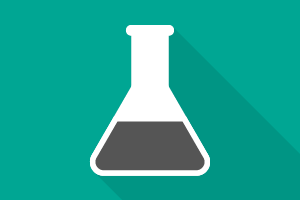Classroom Resources: Chemistry Basics
Filter by:
451 – 475 of 530 Classroom Resources
-

Interdisciplinary, Culminating Project | High School
Project: Chemistry and Art Exhibition Mark as Favorite (14 Favorites)
In this project, students will use chemistry techniques to construct a piece of artwork.
-

Atomic Theory, History, Interdisciplinary, Culminating Project, Model of the Atom | High School, Middle School
Activity: Scientist Infographic Mark as Favorite (50 Favorites)
In this activity, students will design and publish an infographic focused on a well-known scientist and their contribution to the development of the atomic model.
-

Culminating Project | High School
Activity: Second Semester Projects Mark as Favorite (9 Favorites)
In this project, students will choose a topic and express their knowledge using a medium that they feel suits their style.
-

Culminating Project | High School
Activity: Stop-Motion Video Mark as Favorite (3 Favorites)
In this activity, students will pick a concept to bring to life in a stop-motion video.
-

Introduction, Culminating Project | High School
Activity: Toy Project Mark as Favorite (9 Favorites)
In this project, students will develop a toy or elementary school project into an inquiry demonstration suitable for a high school chemistry class.
-

Polyatomic Ions, Review, Ions | High School
Activity: Trade Ions Mark as Favorite (13 Favorites)
In this activity, students will learn common ions by creating notecards and quizzing each other.
-

Introduction, Interdisciplinary, Scientific Method | High School
Activity: Write the Methods Section Mark as Favorite (8 Favorites)
In this activity, students will learn how to write and think like a scientist when they complete their lab write ups.
-

Periodic Table, Elements, Introduction, History, Atoms, Electrons, Subatomic Particles | Middle School, Elementary School, High School
Activity: Writing Your Name using Chemical Element Symbols Mark as Favorite (27 Favorites)
In this activity, students will use their creativity to spell their name (first or middle name and their last name) using chemical symbols of elements on the periodic table. For example, you can spell Yvonne using the symbols for yttrium (Y), vanadium (V), oxygen (O), nitrogen (N), and neon (Ne).
-

History | Middle School, High School
Project: Famous Women Chemists: Snapchat Storyboard Mark as Favorite (13 Favorites)
In this lesson, students will research female chemists and create a 6-panel ‘Snapchat’ storyboard to present the information learned.
-

Temperature, Molecular Motion, Observations, Inferences | High School, Middle School
Demonstration: What is Temperature? Mark as Favorite (64 Favorites)
In this demonstration, students will observe food dye mixing with water at different temperatures.
-

Gas Laws, Matter, Density, Density, Temperature, Pressure, Volume, Graphing, Observations, Measurements | High School, Middle School
Lab: Pressure Bottle Mark as Favorite (4 Favorites)
In this lab, students determine the relationship between volume and pressure of a gas and its temperature and address the common misconception that air does not have mass or density.
-

Activity Series, Chemical Change, Oxidation, Reduction, Net Ionic Equation, Redox Reaction, Observations | High School
Lab: Fine Art of Redox Mark as Favorite (24 Favorites)
In this lab, students will practice writing and balancing redox reactions and use the activity series to verify the outcome of a chemical reaction.
-

Conservation of Mass, Measurements, Conservation of Mass, Chemical Change, Observations, Physical Change, Chemical Change | High School, Middle School
Lab: Mass & Change Mark as Favorite (17 Favorites)
In this lab, students will use unified particle pictures of solid, liquid, and gas to explain the law of conservation of mass after carrying out various experiments.
-

Redox Reaction, Electron Transfer, Chemical Change, Observations, Experimental Design, Scientific Method | High School, Middle School
Lab: Test Tube Geology Mark as Favorite (10 Favorites)
In this lab, students will observe a reaction between an iron nail and copper(II) sulfate in a test tube over the course of several days, modeling how a similar reaction occurs to form copper deposits in the earth. Students will also modify the procedures to evaluate how changing a factor of their choice affects the results of the test tube reaction, introducing them to concepts of experimental design. It also introduces students to my version of the Science Writing Heuristic (SWH).
-

Balancing Equations, Classification of Reactions, Chemical Change, Identifying an Unknown, Molarity, Concentration | High School
Lab: An Environmental Impact Study Mark as Favorite (84 Favorites)
In this lab, students will test a water sample which comes from a local zoo, where, it is reported that many bird eggs are not hatching. Students will test the water for the presence of multiple ions. Once the type of ion in the water is determined, students will write balanced equations to illustrate their findings. Students will also conduct a serial dilution to determine the concentration, or molarity, of the ion in the water sample. This molarity will be compared to known values to determine if the materials in the water are at an unhealthy level.
-

Electromagnetic Spectrum, Atomic Spectra, Electrons, Identifying an Unknown | High School
Lab: The Case of the Contaminated Well Mark as Favorite (115 Favorites)
In this lab, students will observe the colors produced when different metal salt solutions are heated in a flame. Students will take on the role of a forensic investigator and use their results to help them determine if collected evidence was contaminated.
-

Separating Mixtures, Physical Change, Mixtures, Physical Properties, Experimental Design, Scientific Method, Error Analysis | High School, Middle School
Lab: Separation of a Mixture Mark as Favorite (58 Favorites)
In this lab, students devise their own method to separate a mixture of sand, salt, poppy seeds, and iron filings.
-

Chemical Change, Physical Change, Separating Mixtures, Observations, Mixtures, Chemical Properties, Physical Properties, Experimental Design, Scientific Method | High School, Middle School
Lab: Test Tube Separation Mark as Favorite (25 Favorites)
In this lab, students will mix four substances in a test tube and recreate the original four layers through chemical and physical means.
-

Density, Observations, Inferences, Measurements, Identifying an Unknown, Error Analysis, Scientific Method | High School
Lab: Colors of the Rainbow Mark as Favorite (39 Favorites)
In this lab, students will practice density calculations and put their calculations to test by creating their own density column.
-

Polymers, Interdisciplinary, Culminating Project | Middle School, High School
Lesson Plan: Cleaning-up the Plastic Island Mark as Favorite (21 Favorites)
In this lesson, students will develop an understanding of the chemistry of plastics and apply their knowledge in order to engineer a cost effective and environmentally friendly method to clean up the Great Pacific Garbage Patch.
-

Observations, Combustion, Phase Changes, Experimental Design, Scientific Method | High School, Middle School
Lab: Observing a Candle Mark as Favorite (16 Favorites)
In this lab, students accumulate observations of a candle including a look at the combustion reaction's reactants and products.
-

Density, Concentration, Solute & Solvent | High School
Lab: Test Tube Challenge Mark as Favorite (47 Favorites)
In this lab, students will be challenged to create a density column, consisting of three distinct layers of sugar-water solution. This is an inquiry lab, where the students must apply their understanding of density and concentration in order to devise a successful plan for creating the column correctly.
-

Density, Dimensional Analysis, Review, Measurements, Accuracy, Accuracy, Experimental Design, Error Analysis | High School, Middle School
Lab: Bowling Ball—Will it Sink or Float in Water? Mark as Favorite (7 Favorites)
In this lab, students will find the density of a bowling ball to determine whether it will sink or float in water.
-

Conservation of Mass, Observations, Inferences, Matter, Error Analysis | High School
Lab: Investigating Mass Change Mark as Favorite (18 Favorites)
In this lab, students perform seven different investigations in order to develop an understanding of conservation of mass.
-

Significant Figures, Measurements, Accuracy, Density, Accuracy, Error Analysis, Error Analysis | Middle School, High School
Lab: Significant Figures and Lab Data Mark as Favorite (101 Favorites)
In this lesson, students will use laboratory equipment of different precision to collect data for several different metals, and then use the data to calculate the density of each. They will then compare their calculated densities to accepted values and determine the combination of equipment that leads to the most accurate calculation of density.